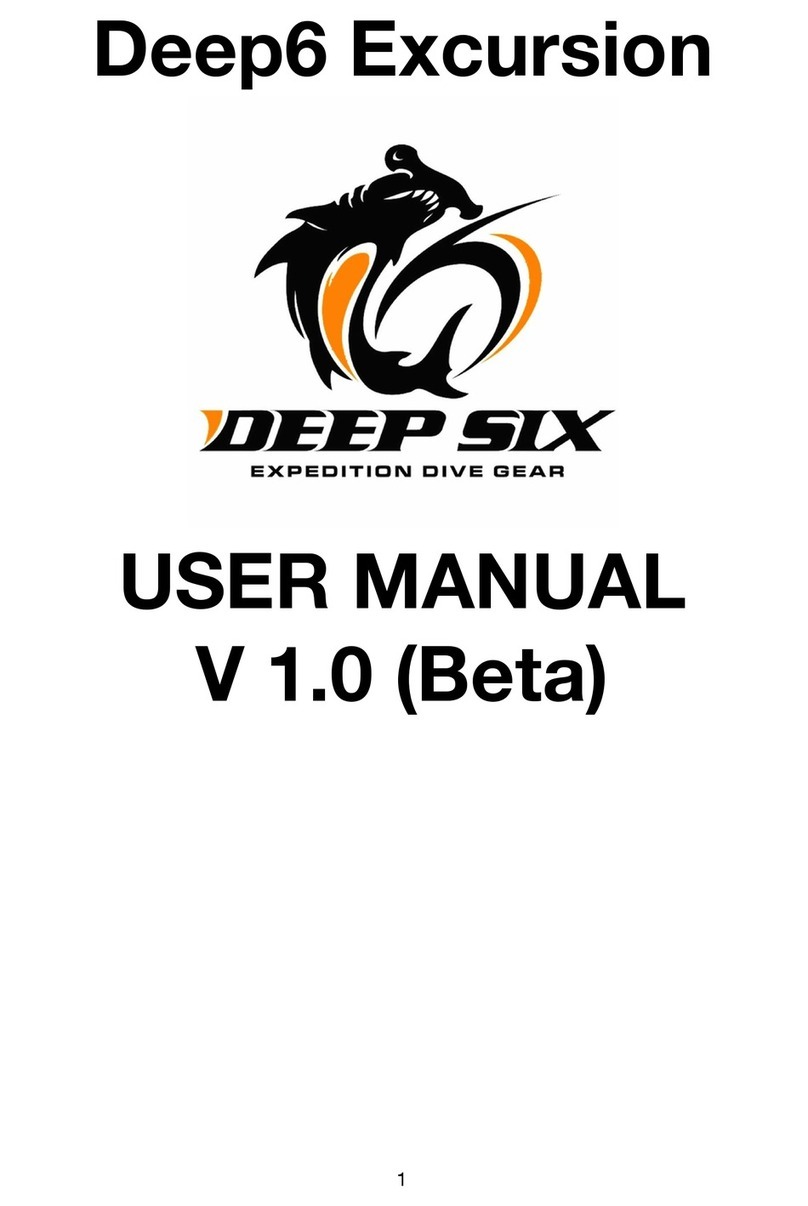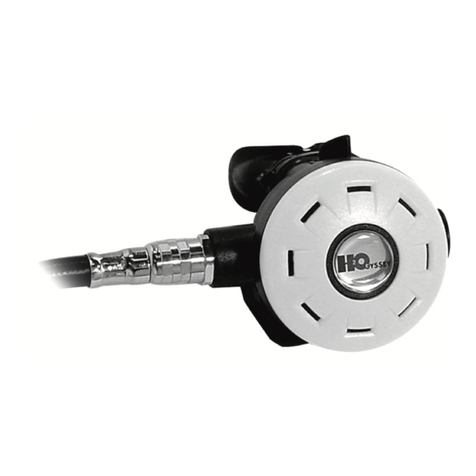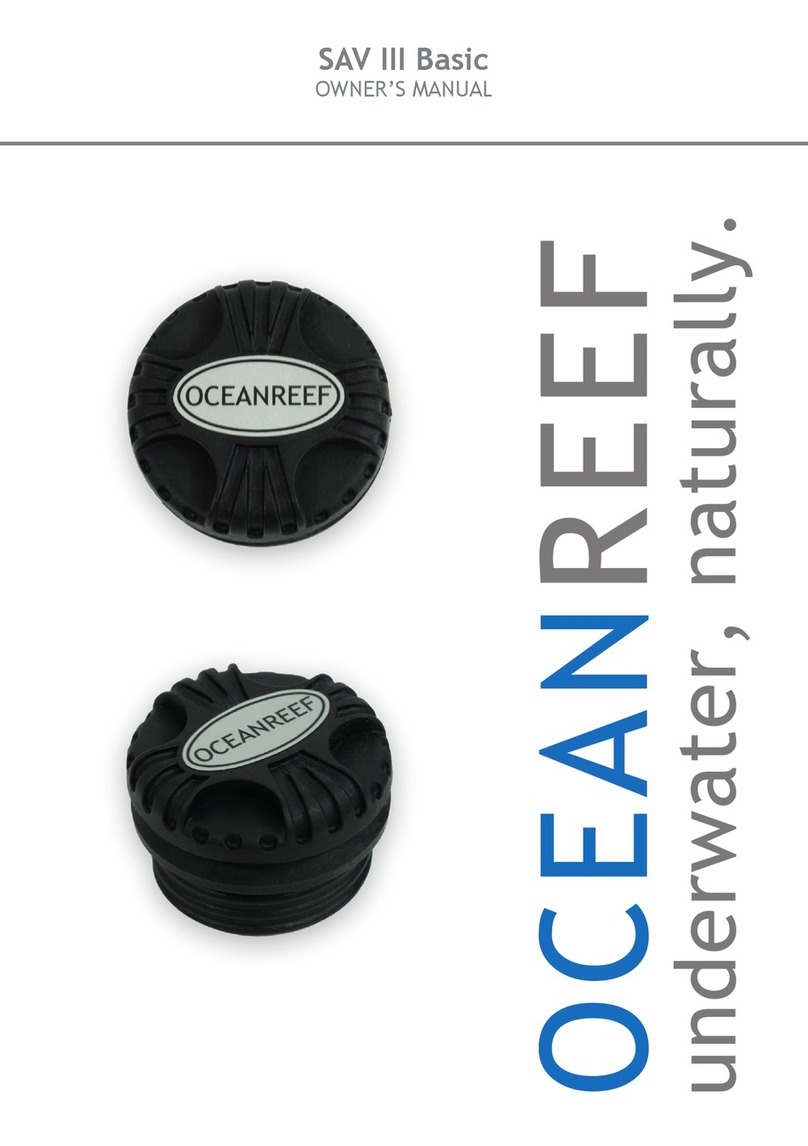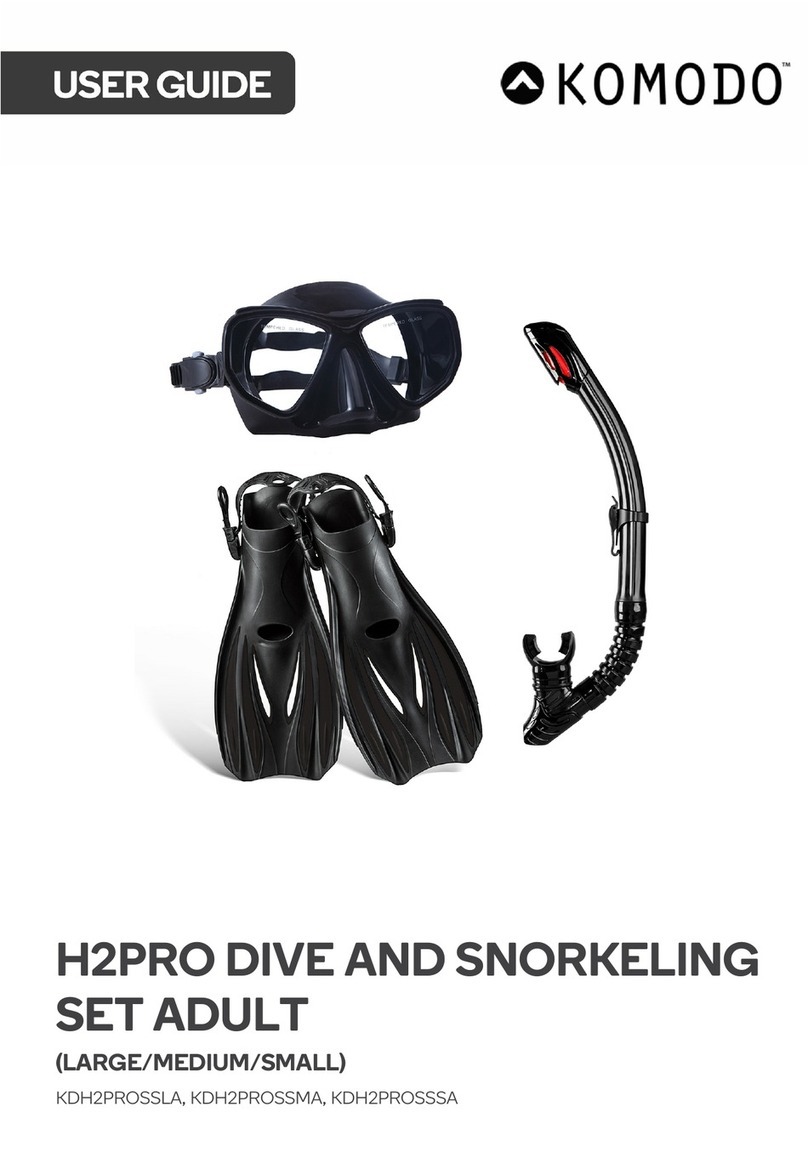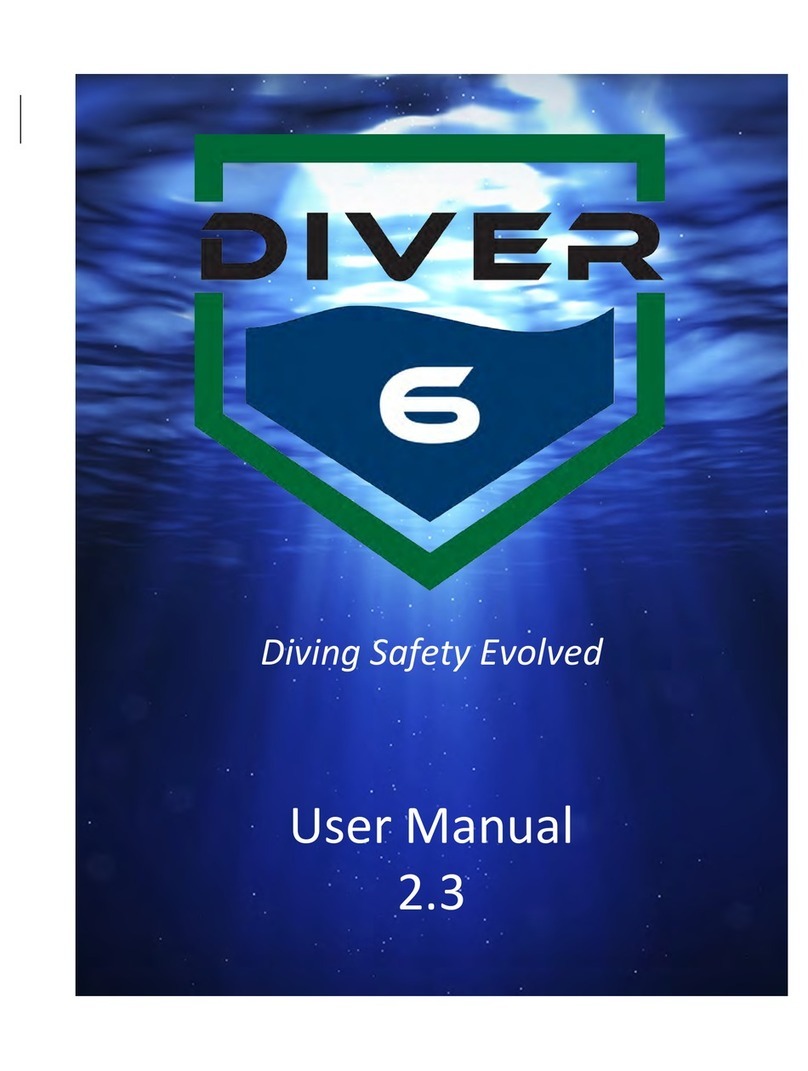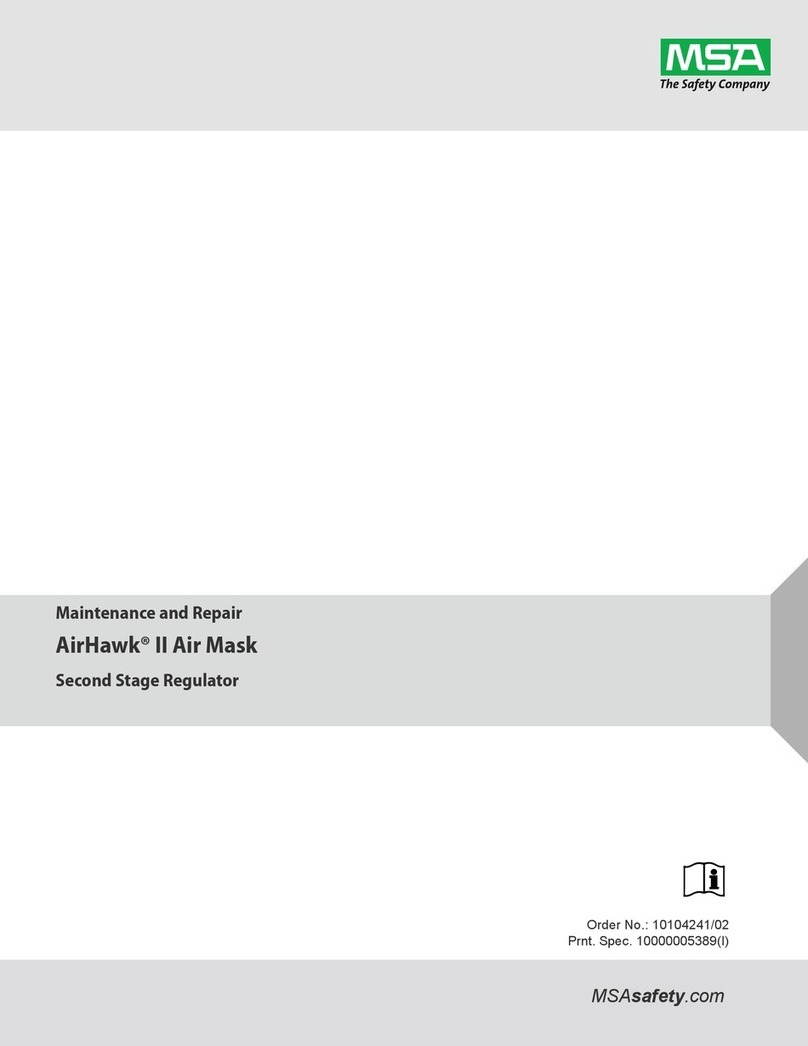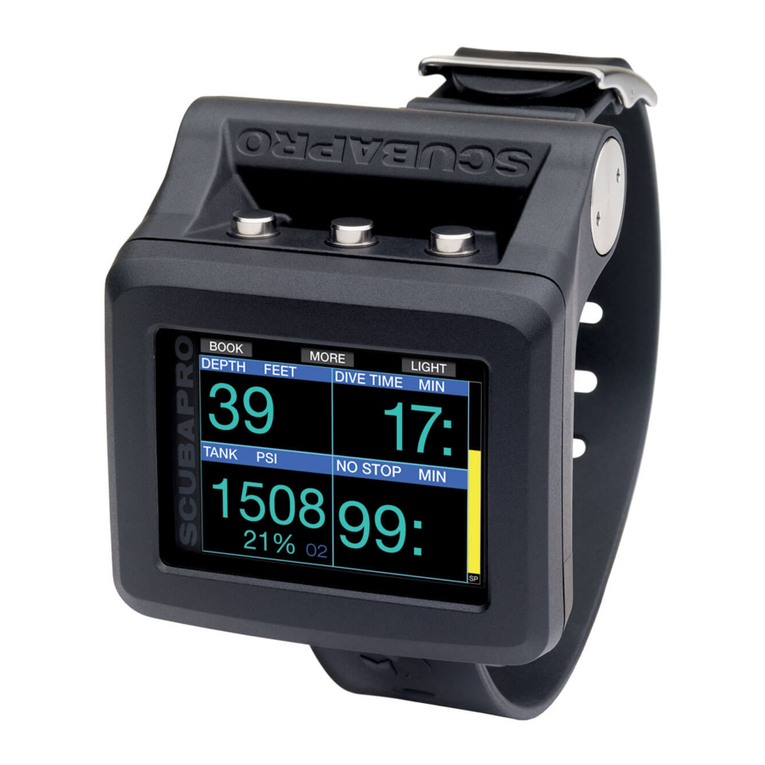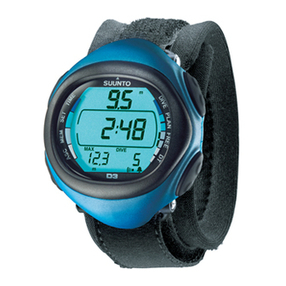Deep 6 SIGNATURE Series User manual

SERVICE MANUAL
SIGNATURE SERIES
SCUBA REGULATORS
©
Version 2.0

2
DEDICATION
This manual is dedicated to those who choose to go the extra distance
and take responsibility for themselves.
Servicing your own gear is not rocket science. It does take patience,
attention to detail, a bit of training and the right tools.
For those explorers who choose to take this path, Deep6 salutes you.
We thank you for your loyalty and support.
Deep Six Expedition Dive Gear is proud to provide you with
the tools you need to explore a world most never see.

3
Table of Contents
Introducon ........................................................................................................5
Service Interval, Cauons, Safety Warnings and Service Training Reminders....6
Recommended Tools ..........................................................................................7
General Consideraons for Servicing Scuba Equipment...................................10
Pre-service Inspecon and Tesng ...................................................................12
First Stage Service
Disassembly.............................................................................................14
Frozen Threads........................................................................................20
Cleaning...................................................................................................21
Reassembly..............................................................................................24
Tuning......................................................................................................30
SPG and Hose Service
SPG and HP Hose.....................................................................................32
Low Pressure Hose ..................................................................................34
BCD Hose.................................................................................................35
Second Stage Service
Disassembly.............................................................................................36
Inspecon................................................................................................41
Cleaning...................................................................................................41
Reassembly (Inial).................................................................................42
Final Reassembly and Tuning..................................................................46
Troubleshoong................................................................................................50
Quick Reference Service Steps
First Stage Service Steps..........................................................................52
Second Stage Service Steps.....................................................................53
First Stage Reassembly Layout (Yoke).....................................................54
First Stage Reassembly Layout (DIN).......................................................55
Second Stage Reassembly Layout ...........................................................56
Service Kit Idencaon Sheets........................................................................57
Signature Regulator Schemacs
First Stage DIN.........................................................................................59
First Stage Yoke.......................................................................................60
Second Stages .........................................................................................61
Appendix A - Faceplate Disassembly.................................................................64

4
Erratum: The rst edion of this manual incorrectly specied a
#6 hook spanner to remove the Diaphragm Clamp and IP Cap.
The correct spanner is a #5 (1.5” eecve arc diameter),
with a 0.156” pin. Use of a larger arc spanner risks pin slippage
and damage to the regulator nish.
© Copyright 2022, Deep Six Expedion Gear

5
Introducon
Deep6 has introduced a regulator set that is built with precision manufactured components designed to
the highest standards in the industry. In our rst stage, computer controlled CNC milling machinery
enables precise component producon. Our specicaons are exacng, yielding consistent performance.
In our Signature Series, addional manufacturing requirements include Teon-impregnated o-rings for
crical components, a durable PVD coang and second stage bodies made with high-impact material.
Our regulators have proven themselves on the most demanding, deep technical dives. But our business
model empowers you to take command of your own service, should you desire. This can signicantly
lower the cost of ownership, placing this extraordinary equipment within the reach of the weekend
recreaonal diver.
Our rst stage oers ve low pressure ports on a swivel that will accommodate virtually any desired hose
roung. Two opposed high pressure ports make both sidemount and backmounted double tank diving
easy to congure. The regulator’s environmentally sealed and precisely balanced diaphragm construcon
yields a low Intermediate Pressure change from full to empty tank. Of special benet to both the vacaon
diver and technical diver, it requires only a quick external rinse for post-dive maintenance.
Our balanced second stage design includes both an adjustable orice and adjustable poppet spring
tension, allowing easy tuning and on-the-y accommodaon of diering breathing requirements between
primary and auxiliary second stages. A precision adjustment of Venturi ow augmentaon provides
smooth breathing at depth, while allowing a quick and easy way to prevent freeow on giant stride from a
boat, even while wearing heavy gloves.
Unique in the industry, our specially-designed “Turbine Piston” ensures laminar ow of breathing gas
down the second stage barrel on its way to the mouthpiece, greatly improving air delivery. The poppet’s
design does not require special alignment during assembly, increasing safety by ensuring complete lever
engagement in any poppet orientaon.
By oering in-person scuba regulator service training courses as well as factory service, Deep6 allows you
to control an unknown that arises with every service interval. Servicing your own equipment can
substanally decrease the cost of ownership. This service manual is your link between your Deep6 service
training and your regulator, helping to ensure that you can maintain your regulators at the same level of
performance as on the day you bought them. Addionally, this document can assist you in diagnosing
problems and making on-site adjustments should problems arise in a remote locaon.
* * *
NOTE: This manual is designed for use ONLY by those divers trained in regulator service by Deep6, or by
professional technicians already trained, experienced and acve in the service of sealed, balanced
diaphragm rst stages and adjustable, balanced, barrel-design second stages.
This manual is organized into broad chapters devoted to:
• General Consideraons, covering safety and tool-handling as covered in your Deep6 training course
• First Stage Service, further divided into Inspecon, Disassembly, Cleaning, Reassembly and Tuning
• Hose and SPG service
• Second Stage Service, further divided as above
• Troubleshoong
• Quick Reference Appendices and Schemacs
Cleaning for oxygen service is discussed in each component secon (1st, 2nd, Hose/SPG) for those who
desire to maintain the regulator’s suitability for oxygen use above 40%.
The Quick Reference chapter contains all crical steps from both 1st and 2nd stage service chapters
without addional discussion, providing the experienced technician with an easily used guide to the proper
order of crical service steps, required tools, o-ring sizes and torque values.

6
Service Interval
Deep6 Signature Series regulators have a service interval of 2 years or 200 dives, whichever comes rst.
Addionally, an Inspecon as described on pages 12-13 must be performed annually. Intermediate
Pressure and second stage cracking eort should be checked regularly, and adjusted as required. The
second stage cover and diaphragm should be removed and the interior rinsed well whenever retained
sand or debris is suspected.
Cauons, Safety Warnings and Service Training Reminders
Throughout the manual you will see symbols prompng cauon, warning you of issues which may aect
your safety, or reminding you of ps you received during service training that may help prevent damage to
your equipment during service.
A CAUTION should prompt you to reread the accompanying or referenced statement and follow its
steps or advice carefully, to avoid making a crical mistake during service that may result in
component damage or out-of-specicaon performance. Cauon statements are not repeated in
the Quick Reference Appendices, and the manual should be consulted whenever a step is encountered
that is not completely familiar to you.
A WARNING alerts you to a safety consideraon which may endanger you either during service or
during subsequent use of the equipment during a dive, if all steps are not followed exactly.
WARNINGS are of such importance that they are repeated in the Quick Reference Appendices.
SPECIFICATION A SPECIFICATION is a value range or liming value aached to a service step that must
be adhered to, to ensure proper performance. Deviaon from a SPECIFICATION may result in damage
during service, equipment failure, or inadequate performance during a dive which may result in death.
A TRAINING REMINDER is noted in the body of the manual where an important piece of
informaon conveyed in training is worth repeang, to ensure best performance. With
experience, these reminders should be well known to an experienced technician, and are not
repeated in the Quick Reference Appendices.
Schemacs
Included at the end of this manual are schemacs for the Signature Series regulators. Parts are numbered
on the schemac and are used throughout the text of this manual to guide you to a specic part on the
schemac. When idencal parts are used in both DIN and Yoke versions of the rst stage, the same
schemac number is used in both DIN and Yoke secons of the manual. Where a part is found only in a
DIN or Yoke rst stage, the schemac number in the text of this manual applies only to the DIN or yoke
schemac respecvely, and the item number is grayed out on the other schemac. Note also that these
item numbers are not the part numbers used in replacement part ordering. Those manufacturing part
numbers which correspond to a given schemac item number are separately listed on each schemac.
How to Use This Manual
Print out pages 54-58 to use during service, as well as whichever of the schemacs on pages 59-63 apply
to your parcular regulators. The remainder of the manual can be viewed on an electronic device, but it is
extremely useful to have paper copies of reassembly parts layout photos and schemacs, to avoid moving
back and forth inside an electronic document. In this fashion, you can proceed methodically through the
steps of the manual, while having references to the parts, tools and torque values close at hand.
Once you are well versed in service, it may be easiest to also print out the Quick Reference Service Steps
on pages 52 and 53, referring to the complete manual as quesons arise.

7
Recommended Tools
The following list contains all tools recommended for service of Signature Series Regulators. On page 8,
where certain of the more expensive tools have an acceptable alternave, the alternave is listed adjacent
to that tool, with accompanying notes. While listed distributors are possible sources for some items, they
are not the only source, and are included as a convenience, rather than a specic recommendaon of any
parcular vendor.
1. Torque Wrench (0-300 in-lb)
2. In-line Second Stage Adjuster
3. Padded Vise
4. Stubby at-bladed screwdriver (not pictured)
5. 3/8” drive handle
6. 3” extension (3/8” drive) for Yoke - special thin prole Scubatools 20-156-500
7. 3/8” drive sockets (3/4” for Yoke; 13/16” deep socket for DIN) (see text, pg. 17)
8. 13/16” open end wrench (or crowfoot aachment) (in lieu of 13/16” deep socket above)
9. Standard L-shaped or T-shaped hex wrenches (4mm, 5mm, 6mm, 8mm)
10. 3/8” drive socket hex keys (4mm, 6mm, 8mm) (straight-sha, NOT ball-end)
11. 11/16” Open-end wrench (or adjustable wrench)
12. 11/16” Thin-prole open end wrench (or thin adjustable wrench)
13. Thin Brass Picks (curved and ball-end)
14. Sharp heavy duty plasc pick, or Apeks tool RG911233
15. Parker brass spade and blunt brass pick
16. 1/8”, 3/16” & 1/4” wooden dowels
17. Intermediate Pressure Gauge with BCD hose adapter
18. Air gun with rubber p (gas pressure limiter recommended)
19. Oxygen-safe lubricant (Tribolube-71, Christolube MCG-111 or equivalent)
20. #5 Hook spanners (two) with 0.156” pins, one with a 3/8” square broach for a torque wrench
21. So bristle brushes for cleaning (toothbrush, so brass bristle)
22. USB microscope for inspecon
23. Padded tray to contain small parts during disassembly and reassembly
24. Apparatus for tesng cracking eort (see page 48)
25. Pressurized breathing gas (Modied Grade E to maintain usability with pure oxygen), 500 & 3000 psi
See tool table with alternaves, next page.

8
ITEM BEST PRACTICE ALTERNATIVES NOTES
Torque Wrench
0-300 in-lb
CDI Dial Type
High quality digital wrench
“Click” type, if calibrated.
A breaker bar, to which is
ed an inexpensive digital
luggage scale, can be used if
funds are limited
Click wrenches are oen
inaccurate at low torque
values.
Pull on a luggage scale
must be at right angles to
the breaker bar.
Surprisingly high accuracy.
In-line Second Stage
Adjuster
Scubatools.com
PN 20-500-200, or
equivalent. Mounted IP
gauge not recommended.
Simple orice adjuster
(must have 5mm hex end)
5mm Hex Key
Second stage tuning by
sequenal hose
disassembly and orice
adjustment is slow, and
slightly less accurate.
Padded Vise Bench Mounted to accept
22 -lb torque
Temporary mount vises can
work if well secured
Padding can include short
lengths of heavy leather
cut from a wide belt, or
thin strips of wood.
3/8” drive ratchet handle
or 3/8” breaker bar
Local hardware store item
3” reduced diameter
extension to ratchet
handle or breaker bar
Scubatools 20-156-500 15” adjustable wrench if
extension can’t be obtained
For Yoke 1st stage only
3/8” drive socket - 3/4” 15” adjustable wrench
(Digital luggage scale will be
needed for accurate
torque)
For Yoke 1st stage only
Adjustable wrench jaws
must be large enough to
span yoke.
3/8” drive socket - 13/16” “Spark Plug Socket” with
chamfer ground at
13/16” crowfoot
aachment
Local hardware store item
For DIN 1st stage only
13/16” crowfoot
aachment (3/8” drive)
13/16” deep socket Alternave to socket above
For DIN 1st stage only
Hex key set,
4, 5, 6, 8mm
Local hardware store item
Straight sha (not ball end)
3/8” drive socket hex key
4mm - straight sha
Do not use ball-end hex
SEE WARNING on page 27.
3/8” drive socket hex key
6mm - straight sha
Hardware store item
DO NOT USE ball-end hex
3/8” drive socket hex key
8mm
Hardware store item
11/16” open end wrench Adjustable wrench Hardware store item
11/16” thin open end
wrench
Divers Wrench Set Thin adjustable wrench
Channellock #6SWCB
Thin Brass Picks Scubatools
PN 10-126-400
Trident #SA75
S heavy duty plasc pick Kinec Wares 30% Glass
Filled Nylon O-ring Pick
Curved sharp brass pick SEE WARNING on page 19
Parker brass spade and
blunt pick
Scubatools PN 10-102-100 No beer value elsewhere
Wooden Dowels 1/8”, 3/16”, 1/4” Home Depot/Lowe’s
Intermediate Pressure
Gauge with BCD
connecon
Scubatools PN 20-165-111 Leisurepro and others Other BCD connector
types available at
Scubatools
Air Gun with rubber p Neiko 31112 Air Blow Gun
Trident AA04 BCD adapter
1/8” wooden or plasc
dowel. Clean coon rags.
See pages 15 & 18 for
further discussion
Oxygen-safe lubricant Tribolube-71
Scubatools PN 15-810-171
Christolube MCG-111
Scubatools PN 15-710-111
List connued on next page

9
ITEM BEST PRACTICE ALTERNATIVES NOTES
#5 Hook Spanner with
0.156” pin
Scubatools
PN 20-405-200
Hinged hook spanner with
appropriate pin
Hinged spanner must be
padded so that pin stays at
right angle to the hole
#5 Hook Spanner with
0.156 pin and torque
broach
Scubatools
PN 20-405-300
Digital luggage scale aached
to hole in spanner to torque
Pull on a luggage scale must
be at right angles to the
spanner.
Cleaning brushes -
Nylon bristle and brass
Toothbrush
Trident #SA28 brass brush
Inspecon microscope Binocular inspecon microscope
- $150-400
USB scope aached to
cellphone or laptop - $30
Google “USB microscope”
Padded work tray
Non-porous for oxygen
cleaning
silicone rubber mat 2mm thick;
cut to t small plasc cafeteria
tray
Small baking tray from
kitchen with silicone pad
added
Raised edges keep small
parts from rolling away
Cracking eort tool Magnehelic 0-3” WC with tubing
and mouthpiece adapter
1) U-tube manometer with
mouthpiece adapter
($2 tubing and $20 for
adapter)
2) Bowl of water and ruler
$0 cost
3) “Feel”
$0 cost
1) A water manometer is just
as accurate, but with a
slower response rate (which
may create inaccuracies)
2) A bowl of water is almost
as accurate, but depends
upon proper esmaon of
diaphragm posion
3) Tuning by “Feel” is
generally very inaccurate
See pg. 48 for discussion
Pressurized
Modied Grade E air
Regulated gas manifold aached
to EAN
Two EAN scuba tanks at 500
and 3000 psi

10
General Consideraons for Servicing Scuba Equipment
The discussion that follows is not instrucon in scuba regulator repair. Together with the TRAINING
REMINDERS in the body of the manual, this secon is intended as a set of operaonal steps that must be
followed to safely and properly service your regulators. Prior to servicing Deep6 equipment, you must
have received formal training by Deep6 or an equivalent scuba equipment manufacturer, and must have
fully reviewed this manual.
1. The Deep6 Signature regulator set is delivered oxygen clean and ready for pure oxygen use up to 2400
psi. In order to maintain that capability, it is essenal that hydrocarbons not be introduced onto regulator
components or tools during servicing. This also means that only hydrocarbon-free air be used in drying
parts and tesng. Gas with a hydrocarbon content that meets scuba standards for oxygen use is known as
“Modied Grade E”. Compressed breathing air from your local scuba shop may not meet modied Grade
E standards, specically, the less than 0.1 mg/cu meter oil mist requirement. The easiest way to ensure
modied Grade E gas is to use Nitrox in the course of your service. The lowest available oxygen
concentraon available economically (EAN32 or EAN21) is generally the best choice. Whenever the term
“clean air” is used in this manual, it refers to Modied Grade E gas as might be obtained from a scuba tank
lled with EAN.
WARNING: Use of a hardware store air compressor to provide pressurized air for disassembly,
drying or tesng is never acceptable. It will render the regulator set suitable only for use with
compressed air.
2. All tools and work surfaces should be maintained clean and free of hydrocarbon contaminants. If
cleaning for oxygen service is ancipated, tools should be specically oxygen cleaned as well. The best
work surfaces are non-porous, as they are most easily cleaned.
3. It is important to maintain a dirt and dust-free shop environment as far as possible. Airborne lint or
microbers can not only serve as fuel in case of ignion, but may land on a sealing surface, resulng in a
dicult-to-diagnose air leak. Lint-free cloth is best for mopping up excess water on newly-cleaned parts.
Specically, “microber” towels are a poor choice. Coon single-layer dish towels with a at weave (no
loops), which have been machine washed prior to use are much beer.
4. Pressurized air used to dry parts prior to assembly carries two risks: loss of parts as they are blown out
of sight, and subcutaneous gas injecon. To prevent the rst, grasp all parts rmly when drying with
pressurized air. Use a maximum of 40 psi whenever possible. Work on a surface with raised edges, such
as a cafeteria tray or baking pan.
WARNING: Prevenon of physical injury due to accidental subcutaneous gas injecon is extremely
important! OSHA denes as a “hazard” any compressed gas exceeding 40 psi. The consequences of
carrying skin bacteria into ssues by accidental injecon of high pressure gas can be catastrophic.
When using an air gun, use a device that limits delivered air pressure to 40 psi, or has a bypass vent that
limits overpressurizaon.
5. TRAINING REMINDER: Whether this manual is viewed in printed format or on an electronic
device, it is strongly recommended that the Schemac and Quick Reference picture be
separately printed out and kept adjacent to your work area. This will save ipping back and forth between
the exploded diagram and the text as the manual is followed during service.
6. Aer disassembly of all components, the corresponding replacement part from the service kit should
be laid out immediately adjacent to the old part unl all parts removed have been matched to the
corresponding service kit part. All old replacement parts should then be removed from the work area.
Thus, at the end of reassembly, no parts should remain on the work surface, serving as a cross-check that
no part has been omied.

11
7. SPECIFICATION It is mandatory that all components which have a required torque value are
reaached with measured torque. Over-torquing can result in thread failure or component fracture.
Under-torquing can result in loosening and detachment under pressure and over me. Either failure can
be life-threatening during a dive. Do not rely on esmates of proper torque.
WARNING: Do not lubricate threaded components unless specically indicated in the manual.
Lubricaon of threads can result in a doubling of the axial load on the threads for a given torque,
and may result in component failure if lubricaon has not been engineered into the torque value.
8. Three components: the first stage high pressure seat (#17), the first stage volcano orifice inside the
regulator body (#13) and the knife edge of the second stage orifice (#28) have zero tolerance
for mishandling and resultant surface damage.
Treat the HP seat extremely gently, and do not allow the polymer face to come in contact with any
metal part or tool during handling. Similarly, the sha of the HP seat must not be scratched. It is
recommended that this part be kept in its plasc envelope unl use, and carefully segregated from other
parts and tools when it is placed on a work surface.
The volcano deep inside the rst stage body must not be allowed to come in contact with any metal
part or tool. Do not insert any metal tool inside the bore of the rst stage body to retrieve a part.
The second stage orice can be easily damaged during removal. Pay parcular aenon to the steps
outlined in the manual during disassembly, and protect the second stage orice by cleaning and storing it
separately from other metal components.
9. With any imperfecon at the interface between the volcano orice and the high pressure seat, you will
have an air leak from the high pressure compartment (from the tank) into the intermediate pressure
compartment (to the second stages). This leak can be temporary, followed by a complete seal, or
connuous. A temporary leak is known as “IP dri”, in which the inial IP reading gradually increases a
few psi, unl the intermediate pressure stabilizes, or “locks up”. This oen occurs even with a perfect
volcano, as the new HP seat molds to the volcano knife edge. It may take several hundred cycles of valve
opening and closing before IP lockup is crisp with no dri.
Conversely, an IP leak which is connuous (the gauge IP pressure does not stop rising), is known as “IP
creep.” IP creep is an out-of-specicaon condion, and requires close inspecon of both the seat and the
volcano inside the regulator body. Note that IP creep can also occur due to a leak past certain o-rings, or a
scratch on the o-ring lands that seal the balance chamber. This was covered in your training.
10. It is crical to inspect and test the regulator set prior to disassembly and service. It does lile good to
replace all the required parts only to nd aer reassembly that an unrecognized problem prevented
eecve service from the outset. Out-of-specicaon performance at tesng can guide you toward the
proper diagnosis of a problem by triggering a closer inspecon of the relevant parts upon disassembly.
11. Use common sense. Do not service your regulator set at the last minute before an important dive trip.
Give yourself an opportunity to test your equipment during a dive that you can abort with minimal
inconvenience. Always remember that scuba diving is unforgiving of mistakes. Use your gear
conservavely on its rst dive aer service, and test it again aerward, following the steps in the next
chapter.

12
PRE-SERVICE INSPECTION AND TESTING
1. Examine the exterior of the regulator set. Look for signs of obvious damage, including cracks in either
the rst stage body or the case of the second. Grasping the rst stage body in one hand, aempt to
unscrew the IP cap by hand where it joins the regulator body. If looseness is found, do not pressurize the
regulator set in step #7 below unl the IP cap (#24) has been ghtened. See page 27. In this case, test the
second stage on a dierent rst stage regulator.
2. Pull back all hose guards (if any), and determine the degree of corrosion beneath the guard. Determine
that all hoses are at least hand ght, and that no o-ring extrusions are visible at port plugs or hose
connecons.
3. Examine the sintered metal lter at the rst stage intake, looking for green verdigris corrosion or rust
staining. This is evidence of salt water entry or tank oxide deposion.
4. Examine all hoses, bending them adjacent to their regulator connecons while looking for cracks in the
outer layer. Conrm that all hose ends are rigid, and the hose does not rotate beneath the swaged end
(SPG hose end excepted). If defects are noted, ensure that the hose in queson will be controlled during
pressurizaon, and that you can immediately depressurize the system.
5. Gently inhale from the second stage with the dust cap rmly occluding the air intake of the rst stage.
It should not be possible to inhale gently. Aempt to determine the source of any leak. While a loose
second stage diaphragm or ineecve exhaust valve are prime culprits, leaks can also occur due to o-ring
failure in the second stage case seals, loose or defecve hoses or a cracked case.
6. Examine the exterior of the SPG (if any). Conrm that the dial face is intact. Slide the gauge from any
console boot (which may require soening the boot in warm water), and conrm that the gauge rotates
with minimal resistance on the hose.
7. Aach an Intermediate Pressure Gauge to the BCD hose, and with one nger pressing lightly on a
second stage purge buon, pressurize the reg set (using eye protecon). Release the purge buon,
allowing the intermediate pressure (IP) to rise.
8. Watch the Intermediate Pressure gauge carefully, looking for a crisp lockup at a pressure within
specicaon. Note the IP. Watch for IP “dri”, a small gradual pressure increase which subsequently locks
up. Watch for IP “creep”, a slow (or fast) intermediate pressure increase which connues to rise above
specicaon, necessitang depressurizaon of the reg set. Be prepared to immediately depress the purge
buon to reduce pressure sent to the second stage while you are turning the tank o, if there is any
evidence of a rapid rise in intermediate pressure above limits.
9. Gently aempt to rotate the pressurized rst stage on the tank, looking for a loose yoke or DIN
housing bolt. Do not rmly try to unscrew the regulator body from its yoke or DIN mount when
pressurized - you may succeed!
10. Look, listen and feel for leaks, nong the locaon.
11. Measure second stage cracking eort, using your choice of measurement method. See discussion on
page 48 below.
12. Breathe gently from the second stage, and watch the IP uctuaon. It should drop 5-10 psi and
return crisply to its lockup pressure.

13
13. Purge the second stage and watch the IP drop during purge. Intermediate pressure should drop less
than 20 psi during a brisk purge with a full (3000 psi) tank. Excessive dynamic IP drop is caused by a) a tank
valve not fully open, b) a parally occluded metal intake lter in the rst stage due to accumulated debris
or corrosion, c) excess fricon among the internal rst stage components, likely caused by internal
corrosion, or d) low tank supply pressure.
14. Immerse the pressurized reg set in water by inverng the tank. Look for evidence of slow leaks from
any connecon. With the second stage mouthpiece facing up when submerged, look for any bubbling.
This may take me to appear, as small bubbles may inially collect in a corner of the case interior before
leaking out of the mouthpiece. Examine the HP hose for a line of ny bubbles along its length, indicang
deterioraon. Rotate the SPG underwater on its swivel connecon to the HP hose, looking for a leak.
15. Aer removal of the reg set from the water, examine the SPG face for water intrusion.
16. Make a list of all defects found, to be addressed in the appropriate service steps that follow.

14
DEEP6 SIGNATURE FIRST STAGE SERVICE
Before beginning service, take photographs or make a diagram of the regulator set to keep track of the
desired hose mounng posions at reassembly.
DISASSEMBLY
1. Remove all hoses together with their second stages and SPG. Remove the yoke knob (if applicable).
In preparaon for diaphragm removal, ll all ports with port plugs except for one high pressure port (for
placement of a vise holder) and one low pressure port on the side of the turret.
2. Aempt to remove the environmental cap by hand,
perhaps using a rubberized sheet for extra “grab.” If it is not
possible to loosen the cap by hand, take a #5 hook spanner
and adjust the 0.156” pin length to the exact depth of the
shallow dimple in the environmental cap (Fig. 1). Ensure that
the hook spanner chosen matches the arc of the
environmental cap precisely, so that the pin engages the
shallow dimple at a right angle to the cap. Any angle in the pin
orientaon due to an over- or undersized hook spanner risks
it slipping during removal, marring the regulator nish.
Always maintain pressure on the hook where the pin
enters the recess on the part to be removed, to avoid
having the spanner “skip out of the hole” and scratch
your nish (Fig. 2).
Whenever removing the environmental cap (#39),
remember to use a second #5 hook spanner to
maintain clockwise pressure on the diaphragm clamp
to prevent inadvertent loosening of the diaphragm (Fig. 3).
Hold the spanners and regulator in a manner similar to the
photo at right to follow both recommendaons above.
Following the training reminders above, remove the
environmental cap (#39) by twisng counterclockwise unl
the cap is loose enough to be removed by hand.
3. Set the environmental cap aside and carefully peel o the
environmental seal (Silicone Disc #38). Do not use a sharp
instrument to remove this part.
Invert the rst stage, allowing the plasc Transpiston (#37)
to fall into your hand (Fig. 4). Set these parts aside.
4. Mount the regulator body in a vise by screwing the large
(7/16”) end of a vise tool into a high pressure port, with the
adjustment cap and diaphragm clamp facing up.
Using a 6mm hex key, unscrew the spring adjuster (#35)
at least three turns (Fig. 5), until it is loose and rotates easily,
to remove mainspring pressure from the diaphragm clamp
(#36).
NOTE: Failure to remove all mainspring pressure on the
diaphragm clamp may result in the clamp springing free
during removal, damaging the last thread.
Fig. 1
Fig. 2
X
Fig. 3
Fig. 4
Fig. 5

15
5. Aach a #5 hook spanner to the diaphragm clamp, with
the 0.156” pin extended to the depth of the recess in the
clamp. Applying counterclockwise force, loosen the
diaphragm clamp using even, increasing pressure (Fig. 6).
If loosening the clamp requires excessive force, refer to the
secon “Frozen Threads” below. Once the diaphragm clamp is
loose, remove the regulator from the vise and invert it so the
clamp is lowermost prior to unscrewing it by hand. This will
prevent several parts from falling out unexpectedly.
Carefully separate the diaphragm clamp and several loose
pieces (below) from the regulator body above (Fig. 7). You
should have a collecon of six pieces (Fig. 8) which includes,
• the diaphragm clamp (#36)
• the spring adjuster (#35)
• an anfricon washer (#33)
• the mainspring (#34)
• a second anfricon washer (#33)
• the spring pad (#32)
Set these parts aside. The diaphragm (#31) normally stays
behind in the regulator body aer clamp removal.
Diaphragm Removal
6. The safest way to remove the diaphragm (#31) is to use air
pressure to pop it out of the regulator body.
Aempng to dig a sened older diaphragm out of the regulator
risks scratching the sealing land, permanently damaging the body.
To remove the diaphragm, place a vise tool in one HP port
using the 7/16” thread end of the vise tool, and mount the
regulator body in a vise with the diaphragm uppermost. Cupping
your hand over the diaphragm to retain dislodged parts, place the
rubber p of an air gun supplied with 40psi clean air rmly against
the sole open LP port in the turret below (Fig. 9). Using a quick
pulse of pressurized air, pop the diaphragm free of the regulator
body (Fig. 10), making sure to keep control of the parts. Li the
diaphragm free of the body (Fig. 11).
If low pressure clean air is not available, do not use any
metal tool to remove the diaphragm. Instead, leave the
diaphragm in place and wait unl Step 13 below, aer
the IP cap is removed. Once the IP cap is removed, use a 1/8”
wooden dowel to push the diaphragm free by passing it
through one of the three bores that pass from the IP side of
the body to the diaphragm side.
7. Then, removing the regulator from the vise, invert it to collect
the valve lier (#30) as it falls free (Fig.12). Resist the temptaon
to remove the valve lier as it sits in place. You risk bending the
sha of the lier during manual extracon. If it is stuck in the HP
seat (#17), it will come loose in step 18 below.
Do not use any metal tool
to remove the diaphragm.
Fig. 6
Fig. 12
Fig. 11
Fig. 9
Fig. 10
Fig. 7
Fig. 8

16
8. Using a 4mm or 5/32” hex key, together with a vise tool
with the small end inserted in an LP port as needed, remove
all remaining LP and HP port plugs.
Yoke or DIN Retainer Removal
During a two-year service interval of salt water diving, the threads connecng the regulator body to
the yoke or DIN retainer become impregnated with salt crystals from water which is forced along
the threads under repeated exposure to several atmospheres of pressure. It can be extremely
dicult to unscrew the retainer from the regulator body. Using a vise tool in an HP port for retainer
removal can damage the threads of the port if signicant force is required to separate the parts.
9. Secure the regulator body in a padded vise with the vise
clamps gently holding the cylindrical sides of the regulator
body (with both HP port plugs removed). Wood strips or 4-6”
strips of heavy leather cut from an old plain belt work well to
protect the nish of the regulator body (Fig. 13).
Do not clamp the regulator body in the vise! Instead,
use the vise only as a rigid container for manipulaon.
10 - Yoke: Aach a 3/4” socket to the yoke retainer, and
engage it with the Scubatools 20-156-500 extension passed
through the threaded hole in the yoke. Connect a 3/8” drive
ratchet handle or (beer) a 12” breaker bar to the extension,
and apply slowly increasing counterclockwise force unl the
retainer loosens (Fig. 14).
If a Scubatools 20-156-500 extension is not available, use a
large (15”) adjustable wrench to span the yoke and grasp both
sides of the yoke retainer (Fig. 15).
If the retainer will not come free with signicant applicaon
of force (> 30 -lb), see the secon “Frozen Threads” below.
Unscrew the yoke retainer until it is free of the body, and lift the yoke (#3), yoke
retainer (#4) and saddle (#12) from the body. If the o-ring (#11) remains behind,
carefully lift it out of the body with a plastic pick.
Do not use a metal pick to remove o-ring (#11). Any scratch on the high pressure lands in the yoke
retainer or the regulator body may result in an irreparable leak.
11 - Yoke: Using a thin wooden dowel, push the lter (#10)
out of the yoke retainer, together with o-ring (#11), if it is sll
in place (Fig. 16).
For connued Yoke Disassembly, skip to step 12 below.
10 - DIN: Place a straight sha 6mm hex key in the broach
of the DIN retainer (#7) and unscrewing counterclockwise
(Fig. 17), remove it from the DIN housing (#9). Do not use a
ball-end hex key in the DIN Retainer. If the retainer will not
come free with signicant applicaon of force (> 20 -lb), see
the secon “Frozen Threads” below.
Remove the 2-012 D90 o-ring (#15) from the DIN Retainer.
Fig. 13
Fig. 14
Fig. 15
Fig. 17
Fig. 16

17
11 - DIN: Aer removing the DIN retainer, li the DIN
Wheel (#8) o the DIN Housing (#9) and set both parts aside.
The DIN Housing is then removed with a 13/16” wrench.
NOTE: If a 13/16” deep socket is your desired tool for
removing the DIN housing, custom modicaon of the socket
may be required to avoid damaging the DIN Housing. The ats
on the Deep6 DIN Housing are low prole to allow free
rotaon of the DIN Wheel (Fig. 18). Most large sockets are
manufactured with a chamfer at the end (Fig. 19) to ease
placement onto a large nut. A chamfer may prevent the
socket from fully engaging the at (Fig. 20), markedly
increasing the shear force applied to the corners of the ats
on the housing during disassembly. You may fracture a point
of the hex on the DIN housing if signicant force is required.
An excellent opon is to prepare a custom tool by
grinding the chamfer o the end of the socket so it fully
engages the ats of the DIN Housing (Fig. 21).
Absent the ability to customize your socket, an open end
wrench that lies ush against the saddle and fully engages the
DIN Housing wrench ats may be a beer choice (Fig. 22).
Similarly, for reassembly and torquing, a crowfoot aachment
to your torque wrench may be a safer tool. Nonetheless, it
should be noted that an open end wrench or crowfoot applies
force to only two of the six ats on the hex ng, which may
make removal risky if there is signicant corrosion.
To disassemble: aach a 13/16” open end wrench or a deep
13/16” socket aached to a ratchet handle or breaker bar
(Fig. 23), and rotate counterclockwise with gradually
increasing force unl the DIN Housing loosens. Maintain rm
downward pressure on the wrench or socket, so that it does
not slip o the ats and spall the part. If the housing resists
removal, see the secon “Frozen Threads” below.
Aer removing the DIN Housing and Saddle (#12), insert
a thin dowel into the housing and push out the lter (#10)
and o-ring (Fig. 24).
Fig. 20
Fig. 23
Fig. 21
Fig. 22
Fig. 18
Fig. 19
Fig. 24

18
12. Once again, mount the regulator in a vise, using a vise
tool placed in a high pressure port. Aach a #5 hook spanner
with the pin extended to the full depth of the recess on the IP
cap (#24), and hold the hook rmly against the cap (Fig. 25).
Rotang counterclockwise, loosen the IP cap with the handle
of the spanner. If loosening the cap requires excessive force,
refer to the secon “Frozen Threads” below.
Then complete removal, unscrewing the IP cap by hand.
13. At this point, if diaphragm removal has not been possible,
use a 1/8” dowel to push the diaphragm free through one of
the three bores in the regulator body (Fig. 26). Then remove
the valve lier. If the valve lier does not fall out, wait unl
Step 18 below.
14. Using a thin pick, remove the 2-024 o-ring (#16) from the
regulator body.
Disassembly of the IP Cap
15. Screw the small end (3/8” thread) of a vise tool into the
open LP port on the side of the turret. Mounng the IP cap
(#24) in a vise with the threaded end up, place an 8mm hex
key in the Swivel Retainer (#22) and using even, increasing
counter-clockwise force, loosen the swivel retainer and
remove it (Fig. 27). If loosening the retainer requires excessive
force, refer to the secon “Frozen Threads” below.
Beneath the swivel retainer is a thrust washer. Do not
lose this part as you separate the swivel turret from the IP cap.
Set the swivel turret aside briey.
If the thrust washer does not fall into your hand, carefully
push it out of the IP cap with a ngerp from the turret side,
rather than using a tool (Fig. 28). Set the IP cap and washer
aside. Retrieving the swivel turret, and using a sharp brass or
plasc pick (Fig. 29), carefully remove the two o-rings (#25 and
#26).
16. Returning to the regulator body, and using a straight-
sha 4mm hex key, loosen but do not remove the balance
plug (#21) (Fig. 30).
Do not use a ball-end 4mm hex key!
Most ball-end hex keys will naturally rest on the HP seat
sha with the waist of the key crossing the broach.
Irreparable damage to the balance plug may occur if force is
applied to the hex broach with the key ats only parally
engaged (Fig. 31). Always use a straight sha 4mm hex! If
loosening the balance plug requires excessive force, refer to
the secon “Frozen Threads” below.
Fig. 26
Fig. 31
Fig. 30
Fig. 29 Fig. 28
Fig. 25
Fig. 27

19
17. With the balance plug loosened, turn the regulator body
balance plug down and unscrew the plug from below (Fig. 32).
Maintain slight upward pressure on the plug as it is unscrewed, as
there is a spring which will otherwise cause it to pop free,
potenally losing crical parts.
18. Carefully lower the balance plug assembly out of the regulator
body. You will have a spring (#19) and HP seat (#17) protruding from
the balance plug (Fig. 33). If the HP seat is retained in the regulator
body, carefully tap the body into the palm of your hand unl the seat
falls free. Resist the temptaon to retrieve the HP seat with a tool.
Any scratch on the sha of the HP seat will render it useless. If it will
not fall free, carefully extract the valve lier (#30) from the other side
of the regulator body, which will release the seat. Set the HP seat and
spring aside, storing the seat separately from other parts to avoid
damage.
19. Using a thin brass pick, remove o-ring #20 from the cap
of the balance chamber.
Carefully inserng a heavy nylon PLASTIC pick into the
balance chamber, hook the outside of the HP o-ring #18 and
push it toward the center (Fig. 34). With the o-ring dislodged,
hook the o-ring with the pick and extract it.
DO NOT USE A METAL PICK TO DISLODGE THE HP
O-RING! Any scratch on the inner land of the balance
chamber will create an irreparable high pressure leak
that will require replacement of the balance chamber.
If it is impossible to remove a hardened old HP o-ring with
the plasc pick, carefully spear the visible poron of the o-ring
with a sharp brass pick (Fig. 35) in as near a vercal manner as
possible, so that the sharp p of the pick never contacts the
land on the inside of the balance chamber. Then pry the
o-ring inward unl it can be removed and discarded. This may
bend your brass pick, but may be the price of removing a
hardened o-ring. Resist the temptaon to use a steel pick.
Set the balance chamber aside.
This completes disassembly of the Signature rst stage.
Fig. 34
Fig. 33
Fig. 35
Fig. 32

20
FROZEN THREADS
Threaded parts which have been repeatedly exposed to salt water at several atmospheres pressure admit
water and salt molecules along the threads which are impossible to rinse out. When the salt crystallizes, it
may cause verdigris corrosion which may “lock” the two parts together requiring a disassembly force far
larger than the installaon torque. Brass components risk deformaon if disassembly forces are excessive.
The following secon discusses ve disassembly techniques (of increasing risk to your equipment) to
separate frozen threaded parts. Although it may be counterintuive, before trying any of these methods,
rst try ghtening your connecon slightly, and then unscrewing. This may break up corrosion crystals.
A) Ultrasonic cleaning, with or without an acid bath, is the most reliable method for loosening frozen
parts. However, plasc parts that are bound up in a frozen assembly may be damaged by ultrasonic
cleaning. Addionally, eecve ultrasonic cleaners with a basin large enough for scuba regulators are
expensive and not commonly available. “Jewelry ultrasonics” oen operate on a higher, less vigorous
frequency than necessary for corrosion removal, and may have only ny basins.
B) Soaking in an acid bath is not as eecve as ultrasonic vibraon, but is possible for all owners. Acec
acid, as a warm soluon of vinegar and water in a 1:1 rao may dissolve the verdigris corrosion and the
salt crystals, allowing a subsequent disassembly aempt to succeed. Extended immersion in acec acid
may remove a ny amount of chrome, and soaking should be limited to a maximum of 10 minutes at a
me before the parts are re-examined for possible damage to the nish.
C) Cold-soaking metal equipment causes all metal parts to individually contract. A 30-minute soak in
ice-water, or two hours in your freezer may (surprisingly) allow disassembly that was not possible before.
CAUTION: A cold soak will make the metal more brile. Do not use anything but slowly increasing
force to disassemble parts aer a cold soak. Specically, avoid tapping on a wrench handle with a
hammer to begin the loosening process.
D) As crystal formaon is at the heart of the process that locks threaded parts together, forces that break
up the crystals may allow disassembly. That is why ultrasonic treatment works so well. As a “last ditch”
step to separate frozen parts, you can use percussive force to shaer the crystals.
Place the parts to be separated on a metal base, such as the closed jaws of a vise. Do not pad the
surface, but choose a smooth, at area on which to set your parts. Allow to warm aer a cold soak trial.
Place a at piece of metal on the top of the pieces to be separated, again choosing as at a surface as
possible on the parts to accept percussion. Taking a small hammer, strike briskly straight down on the
metal covering piece. The cover will accept the small dent that the hammer creates, while distribung the
force to the parts beneath. Use only a medium strike force. It is not the force of the hammer strike that
shaers the crystals, but the sudden shock wave traveling through the locked pieces that does the job.
Examine the parts for cosmec damage, and if none, repeat the strike once more.
Then secure the parts as outlined elsewhere in the manual and again aempt to unscrew them. You
may be surprised at the ease with which they separate.
NOTE: Your parts may sustain slight cosmec damage from this acon. If the only alternave
is buying new parts, this may have to be acceptable.
E) The nal suggeson we have for separang frozen threads is to use WD-40® and me. If the parts are
small enough, you can “waste” an enre can of WD-40® aerosol to ll a small cup and immerse the parts in
queson. Alternavely, heavily spray the joint and come back repeatedly to add new lubricant. Allow at
least four days for capillary acon to draw the WD-40® completely into the threads, and then reaempt
separaon. An alternave compound to WD-40® is Liquid Wrench®.
These ve possible methods have all been used successfully, with varying risk of damage to the
equipment. Aer having to do this once, one sees the value of regular disassembly and service, even when
performance is good and the IP of the rst stage is stable and locks up well over several years. One cannot
undo the eects of neglected service aer repeated immersion in salt water under pressure. Visible
verdigris corrosion along the joint lines of your regulators is a sign that a) beer rinsing aer dives should
have been done, and b) service may be due.
This manual suits for next models
1
Table of contents
Other Deep 6 Diving Instrument manuals
Popular Diving Instrument manuals by other brands
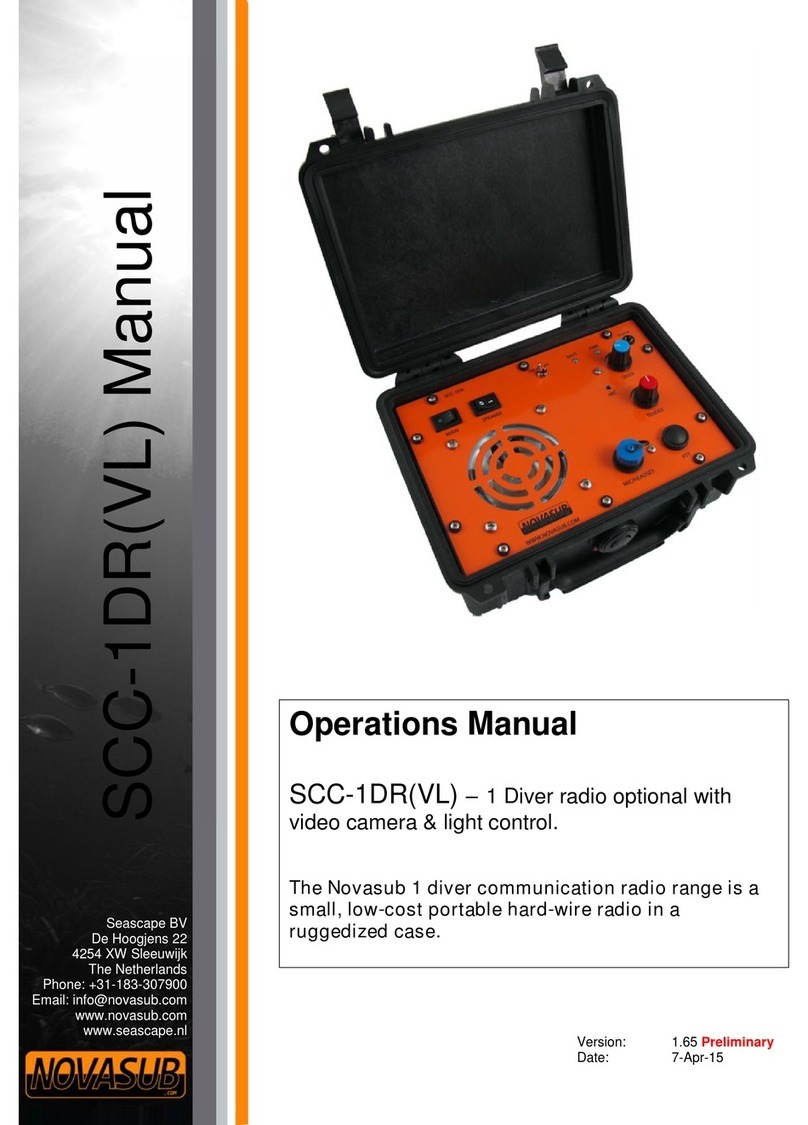
Novasub
Novasub SCC-1DR Operation manual
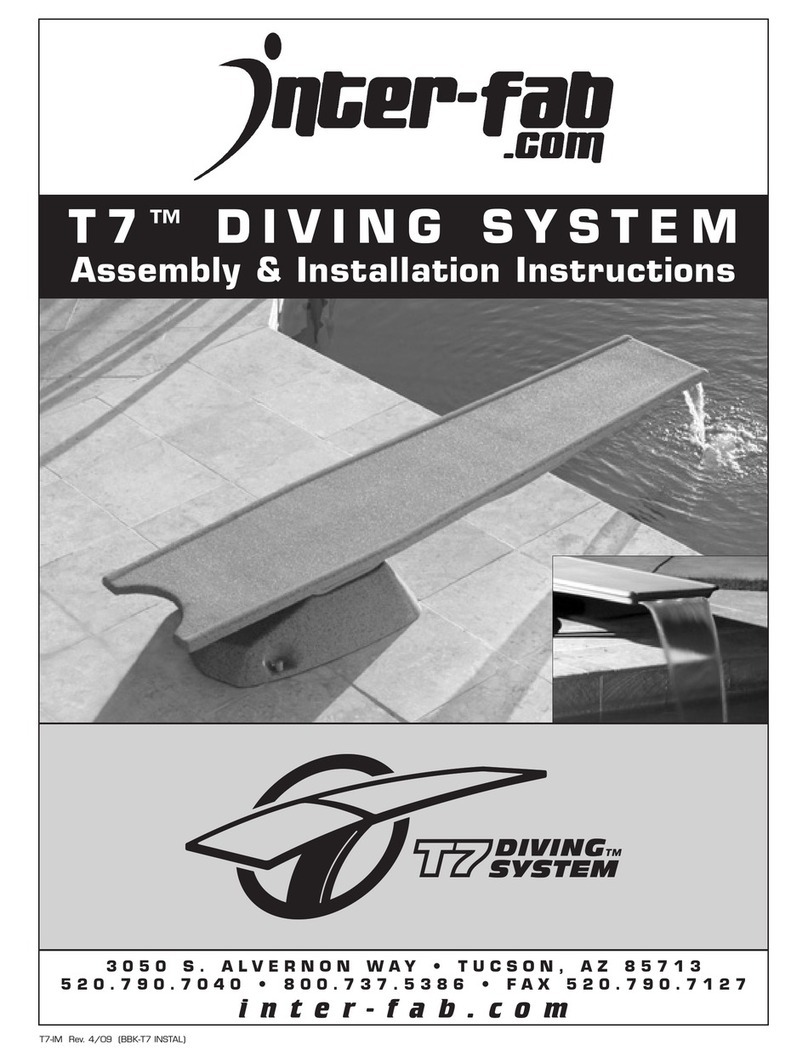
Inter-fab
Inter-fab T7 Assembly/installation instructions
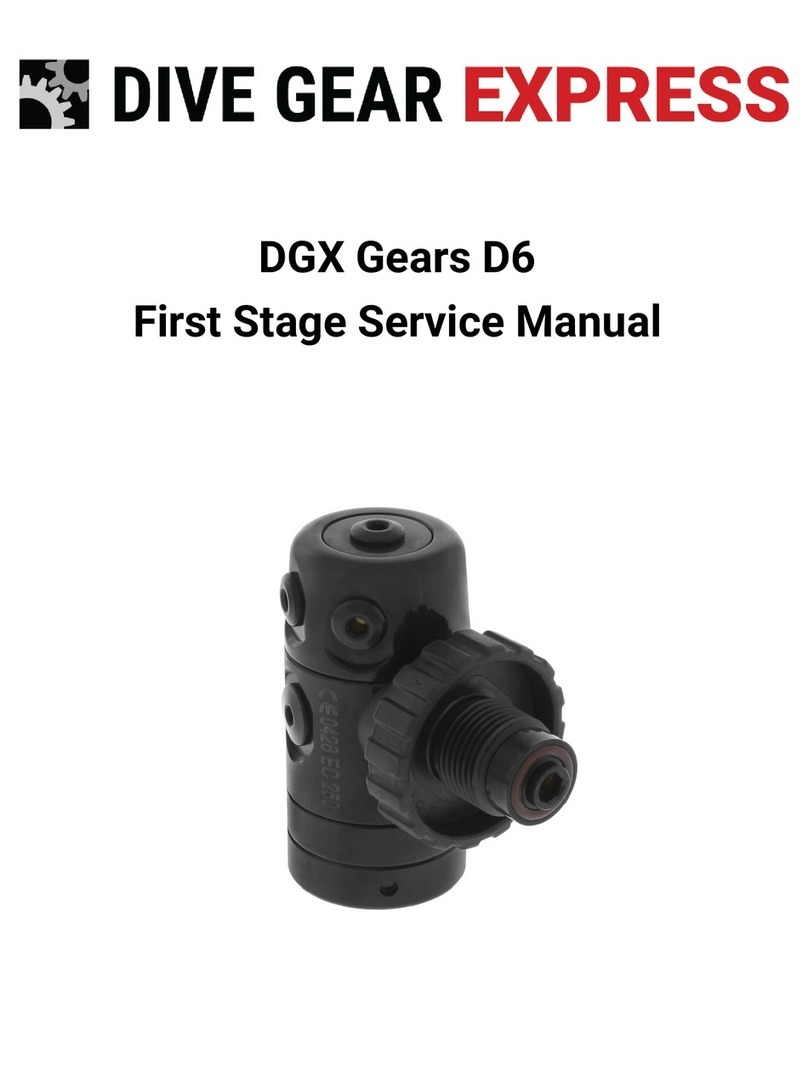
Dive Gear Express
Dive Gear Express DGX Gears D6 First Stage Service Manual

Sherwood Scuba
Sherwood Scuba gemini Repair Program
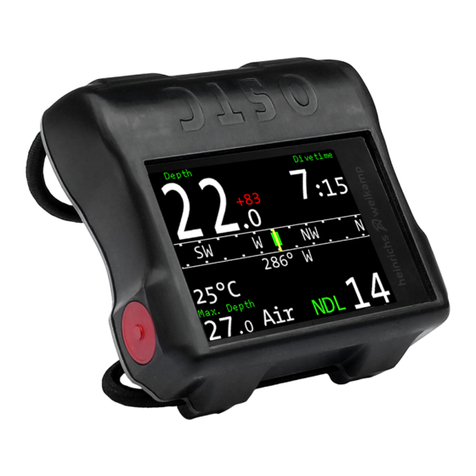
heinrichs weikamp
heinrichs weikamp OSTC Series user manual
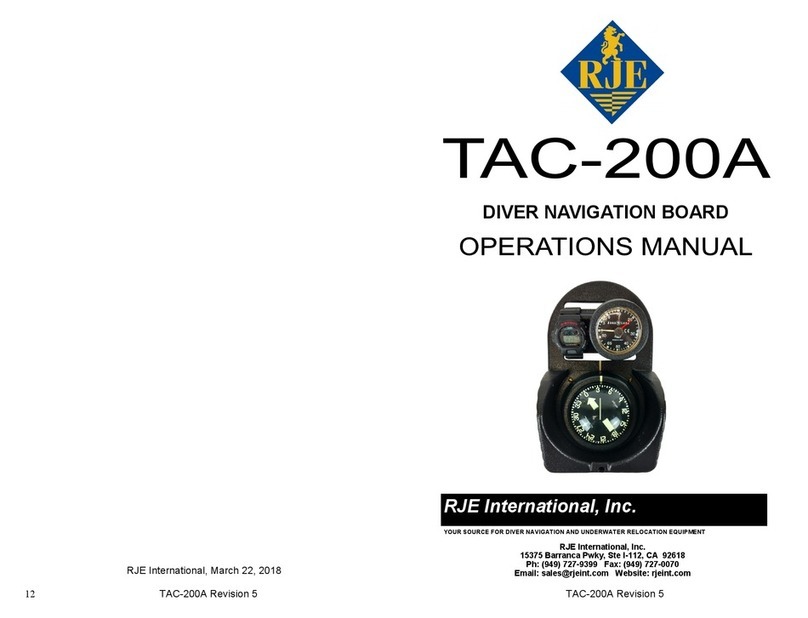
RJE
RJE TAC-200A Operation manual
